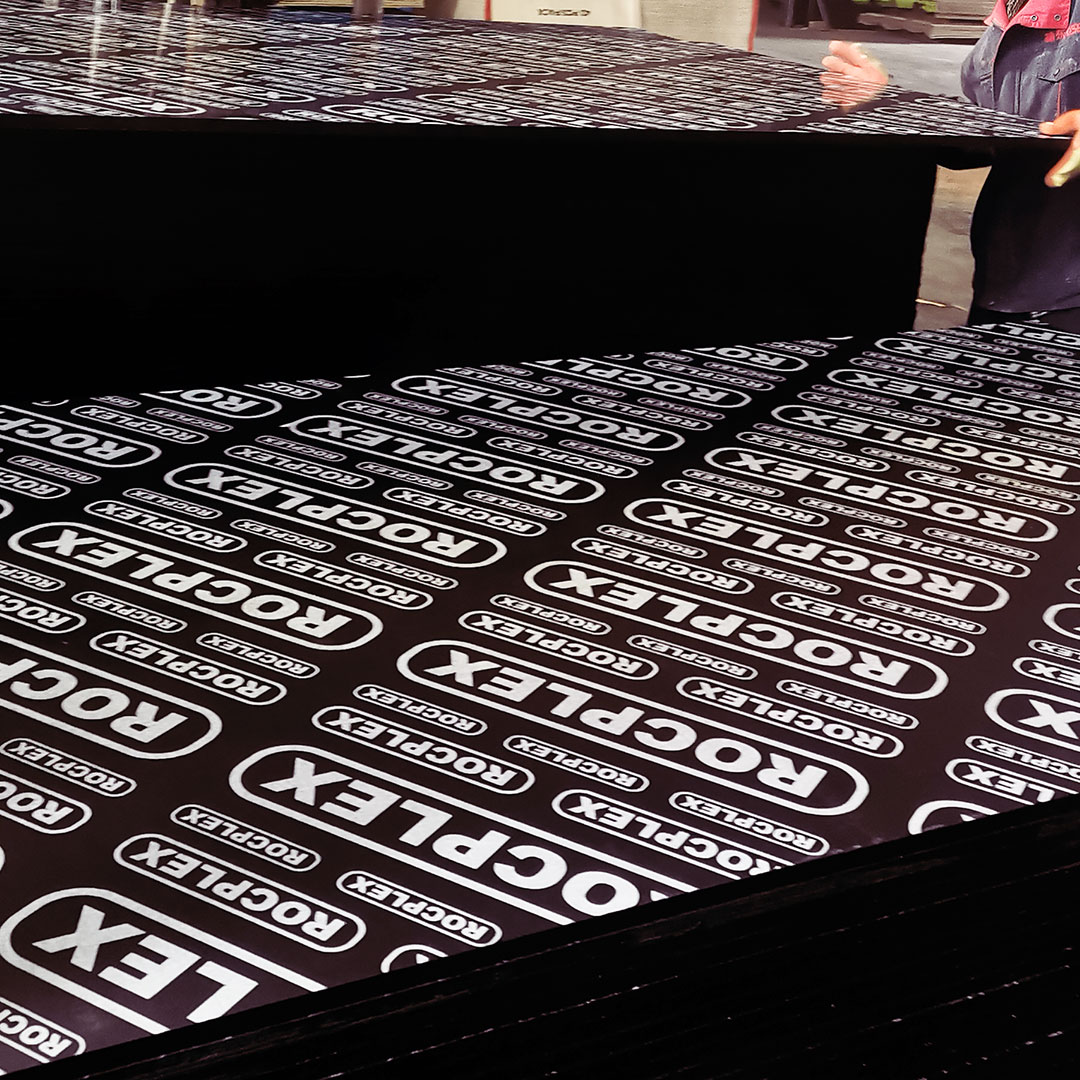Film-faced Plywood is a water-resistant wood formwork that is constructed with a surface coating. The high pressure laminating machine is created by bonding phenolic plywood board and phenolic film into a single. Film Faced Plywood is a widely used building material, an effective mold to make concrete, and can also be used for other purposes such as packaging, home improvement, and DIY.
Structural of Film Faced Plywood
Film Faced Plywood primary woods for the production of formwork include such as eucalyptus and birch combo, poplar, pine.
It is usually made of 7, 9, 11 13 and other odd-numbered veneers, after pressing hot and curing to form a shape.
The connection between the structural veneers that is Film Faced Plywood generally uses the method of mitering or flushing, which is arranged in a cross-section in accordance with the direction of the wood grain.
Therefore, the mechanical properties in the length and width directions of the entire Film Faced Plywood are basically the same.
Specifications for Film Faced Plywood
1220x2440mm is an often used length and width measurement, and the thickness can be between 12mm, 15mm and 18mm.
Bonding properties of Film Faced Plywood
Film Faced Plywood that is used for concrete formwork is a class I plywood that has high weather resistivity and resistance to water, and the adhesive can be a phenolic resin adhesive.
This type of adhesive is characterized by high bonding strength, good water resistance, heat resistance, corrosion resistance and other characteristics. Its outstanding performance is particularly impressive for boiling resistance as well as endurance. There are also chemically changed phenolic glues.
The primary indicators of bonding efficiency are bonding strength and durability.
The bonding strength is the initial bonding capability that means the veneer is completely glued and is strong enough after bonding.
Glue durability is the long-term glue performance, which means that the glue will last after a certain period of time.
The above two indicators are determined by bonding strength tests as well as the test of boiling water immersion.
When buying plywood for concrete formwork, first of all it is essential to determine whether it belongs to Class I plywood, which is, to determine whether the piece of plywood is composed of phenolic resin glue or other adhesives with similar properties. If it is limited by test conditions, and the bonding strength test can't be carried out, it can be assessed by boiling small pieces of test samples.
Plywood made of phenolic resin that is used as an adhesive won't open after being boiled.
Capacity for Carrying of Plywood with Film faces Plywood
The load-bearing capacity of Film Faced Plywood is related to the thickness, static bending strength and flexibility of the wood. Because of the various varieties of trees and the different production areas of the plywood, the mechanical properties of plywood differ as well.
If you need to test the strength of the plywood bearing then you should entrust a professional organization to test the static bending strength and elastic modulus for confirmation.
Classification of Film Faced Plywood
(1) In accordance with the color, it's divided into black, brown or red Film-Faced Plywood.
(2) (2). According to the type of material, it can be classified into hardwood poplar, miscellaneous wood, and Film Faced Plywood.
(3) As per the method, it's divided into a whole core board and finger Jiont plywood.
History of Film Faced Plywood
The Film Faced Plywood for construction was manufactured from China in 1999. It was based on tradition wood forms, which was then combined with the lamination process.
Since 2000, thanks to the continual improvement of the equipment used to manufacture plywood the industry of building formwork has grown rapidly. Since since then, the market been gradually opening up and the plywood industry has been growing rapidly.
Since 2008, the ongoing research and development of plywood material and structures has dramatically improved the quality of plywood along with China Construction film. Faced Plywood is now a popular construction formwork throughout the world.
After more than 20 years of research and promotion the China's building panels are quickly being used across the world because of their high cost performance.
Benefits that come with Film Faced Plywood
(1) When compared to Formwork of steel Faced Plywood is a lot bigger in space and flat surface. It's not just able to cut down on the workload of installation, save labor costs and reduce the cost of any repairs.
(2) (2). The capacity of bearing is huge and the wear resistance on the surface is excellent, and it can be used multiple times.
(3) The weight is light 18mm thick Film Faced Plywood, the weight of one sheet is only around 30kg. Transport, stacking, use and management of the template is more easy;
(4) A good thermal insulation performance, can prevent the temperature from changing too fast, and the construction during winter is useful for the thermal insulation of concrete
(5) It's easy to cut and effortlessly cut in templates with any form;
(6) The bending strength is strong, and is suitable for bending and forming according to the needs of the project. Moreover, it could be used as an outline template.
Construction Configuration of Film Faced Plywood
Simple structural elements are easily made by listing templates specifications and amounts in accordance with structural drawings. The thickness of forms, the width and spacing between the rungs as well as the corrugated timber, and the configuration of the support structure can be calculated and selected according to the needs of the support.
The whole sheet is utilized directly the random cutting process is minimized to reduce the amount of plywood.
(1) The typical thickness of plywood for wood is generally 12 or 18mm. This can be adjusted according on the thickness using design calculations.
(2) The support system can be made using steel pipe scaffolding, wood or H20 beams. When using wood support be sure to use wood that is soft, severely twisted and easily deformed by moisture.
(3) (3) The nails' length must have a length of 1.5 up to 2.5 inches thicker than the thickness of plywood, and at a minimum, 2 nails must be attached to the edges of each corrugated wood and the plywood.
Film Faced Plywood as a wall and Formwork floor construction
Film Faced Plywood is formwork to be used for casting-in-place concrete floors and walls is a popular formwork technique. As compared with combined formwork, it can reduce joints on the surface of concrete, and also meet the requirements that fair-faced concrete must meet.
For wall formwork installation First, you must create one side formwork in accordance with the line of the side, then temporarily hold it up with supports, fix the traction bar in the event of correction after which you can fix it using diagonal braces.
When templates for large-area side panels are assembled the lower and upper vertical seams need to be separated from each other.
In order to ensure the proper thickness of the wall, small squares is a good option to use between the forms on both sides, and the concrete wall must be supported by a water stopper plate. The square-shaped wood must be taken out one by one, along with the pouring concrete.
When putting in the floor formwork you should nail the support in accordance to the horizontal lines, and ensure that the upper part of the support is aligned with that horizontal line. Then place the supports in the middle part and then lay the floor formwork on the supports in the middle.
Safety precautions when using Film Faced Plywood:
(1) Film Faced Plywood increases the durability of the surface, offers good demoulding performance and is smooth and smooth appearance. It is ideal for fair-faced concrete projects with special requirements and no finishing treatment for the outer surface of the concrete for example concrete piers silos, overpasses, chimneys and towers, for example.
(2) (3) Clean the surface of the board as thoroughly as you can after demolding and stack it neatly;
(3) (3) When the formwork is removed, it is not permitted to throw it away so as not to harm the treatment layer that covers the surface.
(4) The edges of plywood are usually waterproofed. Therefore, when cutting the pieces into smaller pieces, it is essential to waterproof the cutting parts;
(5) Try not to drill holes into the board's surface. If holes are reserved, they could be filled with normal wooden boards.
(6) Materials for repair must be readily available at the site to ensure that damaged panels can be repaired at a timely pace.
(7) The act of brushing the release agent prior to use may prolong the service life.
For more knowledge about building formwork, please pay attention to ROCPLEX. Author: ROCPLEX https://www.plywood-price.com Source: ROCPLEX
Post time: Nov-01-2022


